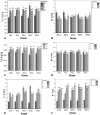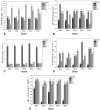Influence of biofertilizer on heavy metal bioremediation and enzyme activities in the soil to revealing the potential for sustainable soil restoration
- PMID: 38001100
- PMCID: PMC10673865
- DOI: 10.1038/s41598-023-44986-8
Influence of biofertilizer on heavy metal bioremediation and enzyme activities in the soil to revealing the potential for sustainable soil restoration
Abstract
Overuse of chemical fertilizer and pesticides in agricultural activity is frequently damaging to soil health and can accumulate heavy metals in the soil environment, causing harm to plants, humans, and the ecosystem. This study was done to evaluate the effectiveness of biofertilizers in reducing heavy metal levels in contaminated soil and enhancing the activity of soil enzymes that are crucial to plant growth and development. Two bacteria strains, Pseudomonas aeruginosa. and Bacillus firmus, were chosen to develop biofertilizers based on molasses. The pot experiment was setup using a completely randomized design with four treatments and five levels; Bacillus firmus and Pseudomonas aeruginosa were used separately, and they were combined for the biofertilizer dose (20, 40, 60, 80, and 100 mL). Utilizing contaminated soils taken from a greenhouse farm the effect of biofertilizer on heavy metal bioremediation and soil enzyme activity was examined. Methods of soil agrochemical analysis were used to determine the soil physiochemical properties and the concentrations of heavy metals Cu, Fe, Zn, Cd, Mo, Mn, were determined by inductively coupled plasma-mass spectrometry ICP-MS, following DTPA extraction methods. In results, soil pH decreased from 8.28 to 7.39, Ec increased from 0.91 to 1.12, organic matter increased from 18.88 to 20.63 g/kg, N increased gradually from 16.7 to 24.4 mg/kg, and K increased from 145.25 to 201.4 mg/kg. The effect of biofertilizer treatment on soil physiochemical characteristics was significantly positive. Application of biofertilizer significantly increased the heavy metal bioavailability and the activities of soil enzymes. Soil pH were positively correlated with soil Zn (0.99819*), APK (0.95869*) activity and negatively correlated with Fe (0.96759*) also statistically significant at (p < 0.05). The soil Cu positively correlated with Fe (0.99645*), Cd (0.97866*), β.D.GLU (0.99769*) and negatively correlated with PAK (- 0.9624*). Soil ARY had positive correlation with soil Mn (0.99683*), Cd (0.95695*), and negative correlation with PAK (- 0.99424*) at (p < 0.05). Soil enzyme activities were negatively correlated to heavy metals at a significant level. Collectively, the study highlights the potential of biofertilizers as a sustainable and effective approach to enhance soil health and remediate heavy metal-contaminated soils in greenhouses.
© 2023. The Author(s).
Conflict of interest statement
The authors declare no competing interests.
Figures


Similar articles
-
[Long-term effects of tillage methods on heavy metal accumulation and availability in purple paddy soil].Huan Jing Ke Xue. 2014 Jun;35(6):2381-91. Huan Jing Ke Xue. 2014. PMID: 25158521 Chinese.
-
Biofertilizer-induced response to cadmium accumulation in Oryza sativa L. grains involving exogenous organic matter and soil bacterial community structure.Ecotoxicol Environ Saf. 2021 Mar 15;211:111952. doi: 10.1016/j.ecoenv.2021.111952. Epub 2021 Jan 26. Ecotoxicol Environ Saf. 2021. PMID: 33513523
-
Effect of bamboo and rice straw biochars on the mobility and redistribution of heavy metals (Cd, Cu, Pb and Zn) in contaminated soil.J Environ Manage. 2017 Jan 15;186(Pt 2):285-292. doi: 10.1016/j.jenvman.2016.05.068. Epub 2016 Jun 2. J Environ Manage. 2017. PMID: 27264699
-
Chelant extraction of heavy metals from contaminated soils.J Hazard Mater. 1999 Apr 23;66(1-2):151-210. doi: 10.1016/s0304-3894(99)00010-2. J Hazard Mater. 1999. PMID: 10379036 Review.
-
Arthropods in soil reclamation and bioremediation: Functional roles, mechanisms and future perspective.J Environ Manage. 2024 Nov;370:122820. doi: 10.1016/j.jenvman.2024.122820. Epub 2024 Oct 10. J Environ Manage. 2024. PMID: 39393333 Review.
Cited by
-
Combined Application of Biochar and Plant Growth-Promoting Rhizobacteria Improves Heavy Metal and Drought Stress Tolerance in Zea mays.Plants (Basel). 2024 Apr 19;13(8):1143. doi: 10.3390/plants13081143. Plants (Basel). 2024. PMID: 38674552 Free PMC article.
-
Soil fungal networks exhibit sparser interactions than bacterial networks in diseased banana plantations.Appl Environ Microbiol. 2024 Dec 18;90(12):e0157224. doi: 10.1128/aem.01572-24. Epub 2024 Nov 8. Appl Environ Microbiol. 2024. PMID: 39513723 Free PMC article.
-
Advances in microbial based bio-inoculum for amelioration of soil health and sustainable crop production.Curr Res Microb Sci. 2024 Jun 20;7:100251. doi: 10.1016/j.crmicr.2024.100251. eCollection 2024. Curr Res Microb Sci. 2024. PMID: 39165409 Free PMC article. Review.
-
Microbiological Mechanisms of Collaborative Remediation of Cadmium-Contaminated Soil with Bacillus cereus and Lawn Plants.Plants (Basel). 2024 May 9;13(10):1303. doi: 10.3390/plants13101303. Plants (Basel). 2024. PMID: 38794373 Free PMC article.
-
Optimizing copper phytoremediation and mung bean (Vigna radiata L.) yield through Sinorhizobium meliloti and Piriformospora indica inoculation.Sci Rep. 2025 May 28;15(1):18759. doi: 10.1038/s41598-025-01681-0. Sci Rep. 2025. PMID: 40436908 Free PMC article.
References
-
- Khan MN, Mobin M, Abbas ZK, Alamri SA. Fertilizers and their contaminants in soils, surface and groundwater. Encycl. Anthr. 2018;5:225–240. doi: 10.1016/B978-0-12-809665-9.09888-8. - DOI
-
- Youssef MMA, Eissa MFM. Biofertilizers and their role in management of plant parasitic nematodes. A review. J. Biotechnol. Pharm. Res. 2014;5:1–6.
-
- Kawalekar JS. Role of biofertilizers and biopesticides for sustainable agriculture. J. Bio Innov. 2013;2:73–78.
-
- Raghuwanshi R. Opportunities and challenges to sustainable agriculture in India. Nebio. 2012;3:78–86.
-
- Bumandalai O, Tserennadmid R. Effect of Chlorella vulgaris as a biofertilizer on germination of tomato and cucumber seeds. Int. J. Aquat. Biol. 2019;7:95–99.
MeSH terms
Substances
Grants and funding
- ("YZ2022060")/Key Research and Development Projects (social development) in Yangzhou China
- ("YZ2022060")/Key Research and Development Projects (social development) in Yangzhou China
- ("YZ2022060")/Key Research and Development Projects (social development) in Yangzhou China
- ("YZ2022060")/Key Research and Development Projects (social development) in Yangzhou China
- ("YZ2022060")/Key Research and Development Projects (social development) in Yangzhou China
LinkOut - more resources
Full Text Sources

